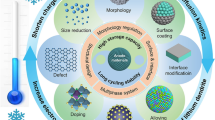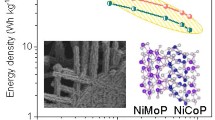Abstract
Binder-free Ni/NiO microwire hybrid network with a nanostructured surface is synthesized by employing a facile and low-cost method, involving one-pot synthesis of Ni microwires, followed by their partial oxidation in air atmosphere. A combination of imaging, diffraction, thermodynamic and electrochemical methods has been applied to reveal the impact of the synthesis conditions on the energy storage performance of the Ni/NiO microwire networks. The thermal conditions for the synthesis have been optimized by means of thermogravimetric (TGA/DSC) analysis, where an appropriate temperature (T = 400 °C) for obtaining a low-defect NiO phase has been determined. The performed electrochemical characterisation of the materials has shown that setting a low temperature for the synthesis enables high reversible capacity and better cycling stability of the binder-free materials. When the Ni/NiO network structures are deposited by a conventional slurry-based technology, involving polymer binder and conductive additive, the high capacity and cycling stability of the anodes are preserved, independent of the temperature conditions of synthesis. Electrochemical impedance spectroscopy is applied to support the interpretation of our results.
Graphic abstract









Similar content being viewed by others
References
Nitta N, Wu F, Lee JT, Yushin G (2015) Li-ion battery materials: present and future. Mater Today 18:252–264. https://doi.org/10.1016/j.mattod.2014.10.040
Veluri PS, Mitra S (2017) High-Rate Capable Full-Cell Lithium-Ion Battery based on a Conversion Anode and an Intercalation Cathode. ChemElectroChem 4:686–691. https://doi.org/10.1002/celc.201600681
Goodenough J, Kim Y (2011) Challenges for rechargeable batteries. J Power Sour 196:6688–6694. https://doi.org/10.1016/j.jpowsour.2010.11.074
Poizot P, Laruelle S, Grugeon S, Dupont L, Tarascon J-M (2000) Nano-sized transition-metal oxides as negative-electrode materials for lithium-ion batteries. Nature 407:496–499. https://doi.org/10.1038/35035045
Li X, Dhanabalan A, Wang C (2011) Enhanced electrochemical performance of porous NiO–Ni nanocomposite anode for lithium ion batteries. J Power Sour 196:9625–9630. https://doi.org/10.1016/j.jpowsour.2011.06.097
Wang C, Wang D, Wang Q, Chen H (2010) Fabrication and lithium storage performance of three-dimensional porous NiO as anode for lithium-ion battery. J Power Sour 195:7432–7437. https://doi.org/10.1016/j.jpowsour.2010.04.090
Varghese B, Reddy MV, Yanwu Z, Lit CS, Hoong TC, Rao GVS et al (2008) Fabrication of NiO nanowall electrodes for high performance lithium ion battery. Chem Mater 20:3360–3367. https://doi.org/10.1021/cm703512k
Wang Y, Qin Q-Z (2002) A Nanocrystalline NiO Thin-Film Electrode Prepared by Pulsed Laser Ablation for Li-Ion Batteries. J Electrochem Soc 149(7):A873–A878. https://doi.org/10.1149/1.1481715
Gu Y, Federici J (2018) Fabrication of a Flexible Current Collector for Lithium Ion Batteries by Inkjet Printing. Batteries 4(3):42. https://doi.org/10.3390/batteries4030042
Liang M, Zhao M, Wang H, Wang F, Song X (2018) Excellent cycling stabilities of a novel calliandra-like Co3O4 acted as anode materials for the lithium-ion battery. J Energy Storage 17:311–317. https://doi.org/10.1016/j.est.2018.03.017
Huang X, Tu J, Zhang B, Zhang C, Li Y, Yuan Y et al (2006) Electrochemical properties of NiO–Ni nanocomposite as anode material for lithium ion batteries. J Power Sour 161:541–544. https://doi.org/10.1016/j.jpowsour.2006.03.039
Wu M-S, Lin Y-P (2011) Monodispersed macroporous architecture of nickel-oxide film as an anode material for thin-film lithium-ion batteries. Electrochimica Acta 56:2068–2073. https://doi.org/10.1016/j.electacta.2010.11.089
Kottegoda IR, Idris NH, Lu L, Wang J-Z, Liu H-K (2011) Synthesis and characterization of graphene–nickel oxide nanostructures for fast charge–discharge application. Electrochimica Acta 56:5815–5822. https://doi.org/10.1016/j.electacta.2011.03.143
Zhu X-J, Hu J, Dai H-L, Ding L, Jiang L (2012) Reduced graphene oxide and nanosheet-based nickel oxide microsphere composite as an anode material for lithium ion battery. Electrochim Acta 64:23–28. https://doi.org/10.1016/j.electacta.2011.12.040
Huang X, Tu J, Zhang C, Chen X, Yuan Y, Wu H (2007) Spherical NiO-C composite for anode material of lithium ion batteries. Electrochim Acta 52:4177–4181. https://doi.org/10.1016/j.electacta.2006.11.034
Hosono E, Fujihara S, Honma I, Zhou H (2006) The high power and high energy densities Li ion storage device by nanocrystalline and mesoporous Ni/NiO covered structure. Electrochem Commun 8:284–288. https://doi.org/10.1016/j.elecom.2005.11.023
Liu C, Li C, Ahmed K, Mutlu Z, Ozkan CS, Ozkan M (2016) Template free and binderless nio nanowire foam for li-ion battery anodes with long cycle life and ultrahigh rate capability. Sci Rep 6:29183. https://doi.org/10.1038/srep29183
Hasan M, Jamal M, Razeeb KM (2012) Coaxial NiO/Ni nanowire arrays for high performance pseudocapacitor applications. Electrochim Acta 60:193–200. https://doi.org/10.1016/j.electacta.2011.11.039
Liu C, Li C, Wang W, Ozkan M, Ozkan CS (2016) Facile synthesis of nickel nanofoam architectures for applications in li-ion batteries. Energy Technol 5(3):422–427. https://doi.org/10.1002/ente.201600306
Zhang Q, Huang S-Z, Jin J, Liu J, Li Y, Wang H-E et al (2016) Engineering 3D bicontinuous hierarchically macro-mesoporous LiFePO4/C nanocomposite for lithium storage with high rate capability and long cycle stability. Sci Rep 6:25942. https://doi.org/10.1038/srep25942
Xu Y, Zhou M, Lei Y (2016) rechargeable batteries: nanoarchitectured array electrodes for rechargeable lithium- and sodium-ion batteries. Adv Energy Mater 6:1502514. https://doi.org/10.1002/aenm.201670057
Lei Y, Daffos B, Taberna P, Simon P, Favier F (2010) MnO2-coated Ni nanorods: enhanced high rate behavior in pseudo-capacitive supercapacitor. Electrochim Acta 55:7454–7459. https://doi.org/10.1016/j.electacta.2010.03.012
Li X, Han C (2007) Directional role of weak magnetic field on the self-fabrication of ordered nickel chains. J Cryst Growth 309:60–64. https://doi.org/10.1016/j.jcrysgro.2007.09.015
Morozov MV, Gilmutdinov AK, Salakhov MK (2013) Synthesis of nickel microwires with nanostructured surface for electrodes of chemical current sources. J Phys: Conf Ser 478:012014. https://doi.org/10.1088/1742-6596/478/1/012014
Sarkar S, Sinha AK, Pradhan M, Basu M, Negishi Y, Pal T (2010) Redox transmetalation of prickly nickel nanowires for morphology controlled hierarchical synthesis of nickel/gold nanostructures for enhanced catalytic activity and sers responsive functional material. J Phys Chem C 115:1659–1673. https://doi.org/10.1021/jp109572c
Xia Z, Wen W (2016) Synthesis of nickel nanowires with tunable characteristics. Nanomaterials 6:19. https://doi.org/10.3390/nano6010019
Freitas M, Silva RSE, Anjos D, Rozario A, Manoel P (2007) Effect of synthesis conditions on characteristics of the precursor material used in NiOOH/Ni(OH)2 electrodes of alkaline batteries. J Power Sour 165:916–921. https://doi.org/10.1016/j.jpowsour.2006.11.026
Tientong J, Garcia S, Thurber CR, Golden TD (2014) Synthesis of nickel and nickel hydroxide nanopowders by simplified chemical reduction. J Nanotechnol 1:6. https://doi.org/10.1155/2014/193162
Tilley RGD (2008) Defects in Solids. John Wiley & Sons. ISBN: 978-0-470-38073-4.
Ren Y, Chim WK, Chiam SY, Huang JQ, Pi C, Pan JS (2010) Formation of nickel oxide nanotubes with uniform wall thickness by low-temperature thermal oxidation through understanding the limiting effect of vacancy diffusion and the kirkendall phenomenon. Adv Func Mater 20:3336–3342. https://doi.org/10.1002/adfm.201000498
Sun Y, Liu N, Cui Y (2016) Promises and challenges of nanomaterials for lithium-based rechargeable batteries. Nat Energy. https://doi.org/10.1038/nenergy.2016.71
Rahman MA, Wen C (2015) Nanogravel structured NiO/Ni foam as electrode for high-performance lithium-ion batteries. Ionics 21:2709–2723. https://doi.org/10.1007/s11581-015-1475-2
Zhu Y, Wang C (2010) Novel CV for phase transformation electrodes. J Phys Chem C 115:823–832. https://doi.org/10.1021/jp109954y
Barai A, Chouchelamane GH, Guo Y, Mcgordon A, Jennings P (2015) A study on the impact of lithium-ion cell relaxation on electrochemical impedance spectroscopy. J Power Sour 280:74–80. https://doi.org/10.1016/j.jpowsour.2015.01.097
Li J, Murphy E, Winnick J, Kohl PA (2001) The effects of pulse charging on cycling characteristics of commercial lithium-ion batteries. J Power Sour 102:302–309. https://doi.org/10.1016/s0378-7753(01)00820-5
Wang H, Pan Q, Wang X, Yin G, Zhao J (2009) Improving electrochemical performance of NiO films by electrodeposition on foam nickel substrates. J Appl Electrochem 39:1597–1602. https://doi.org/10.1007/s10800-009-9848-8
Huang X, Tu J, Xia X, Wang X, Xiang J, Zhang L et al (2009) Morphology effect on the electrochemical performance of NiO films as anodes for lithium ion batteries. J Power Sour 188:588–591. https://doi.org/10.1016/j.jpowsour.2008.11.111
Kim G-P, Park S, Nam I, Park J, Yi J (2013) Synthesis of porous NiO materials with preferentially oriented crystalline structures with enhanced stability as lithium ion battery anodes. J Power Sour 237:172–177. https://doi.org/10.1016/j.jpowsour.2013.03.046
Zhong J, Wang X, Xia X, Gu C, Xiang J, Zhang J et al (2011) Self-assembled sandwich-like NiO film and its application for Li-ion batteries. J Alloy Compd 509:3889–3893. https://doi.org/10.1016/j.jallcom.2010.12.151
Chiu K-F, Chang CY, Lin CM (2005) The electrochemical performance of bias-sputter-deposited nanocrystalline nickel oxide thin films toward lithium. J Electrochem Soc 152(6):A1188–A1192. https://doi.org/10.1149/1.1906024
Acknowledgements
The reported study was funded by RFBR according to the research project № 19-03-00345. M.M. is thankful for funding of the application of fibers for electrodes within the joint program of DAAD and Russian Ministry of Science and Higher Education «Mikhail Lomonosov II», project № 16.13419.2019/13.2. We thank for fruitful discussions Albert Gilmutdinov and for technical support Michael Stich (electrode preparation) and Christian Suchomski (XRD measurements). SEM and TEM measurements were performed using the equipment of Center for collective use «Applied Nanotechnologies» of KNRTU-KAI, we thank for its operation Sergey Drobyshev.
Author information
Authors and Affiliations
Corresponding author
Ethics declarations
Conflict of interest
The authors declare that they have no conflict of interest.
Additional information
Publisher's Note
Springer Nature remains neutral with regard to jurisdictional claims in published maps and institutional affiliations.
Supplementary Information
Below is the link to the electronic supplementary material.
Rights and permissions
About this article
Cite this article
Morozov, M., Ivanov, S., Kadirov, M. et al. Facile synthesis of a binder-free 3D Ni/NiO microwire network with a nanostructured fiber surface for a negative electrode in Li-ion battery. J Appl Electrochem 51, 815–828 (2021). https://doi.org/10.1007/s10800-021-01541-5
Received:
Accepted:
Published:
Issue Date:
DOI: https://doi.org/10.1007/s10800-021-01541-5




